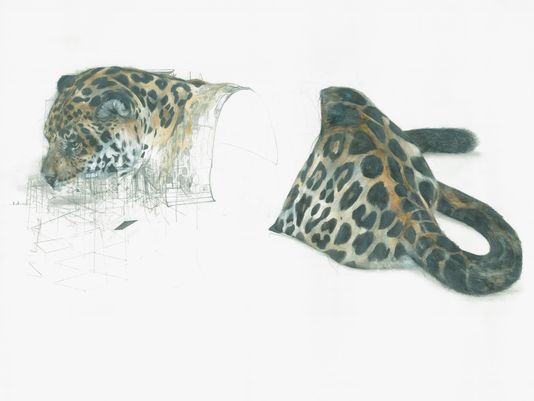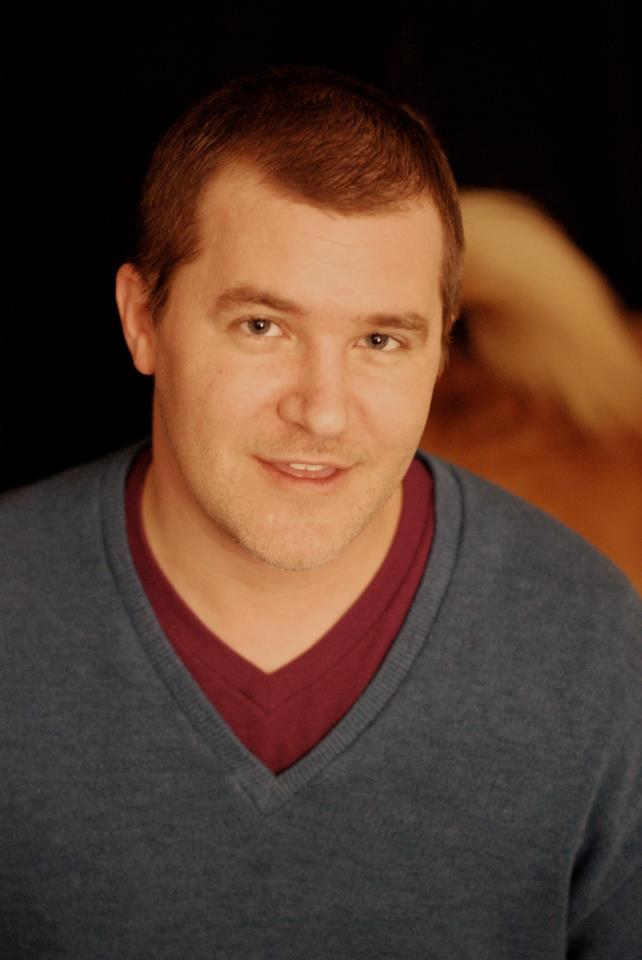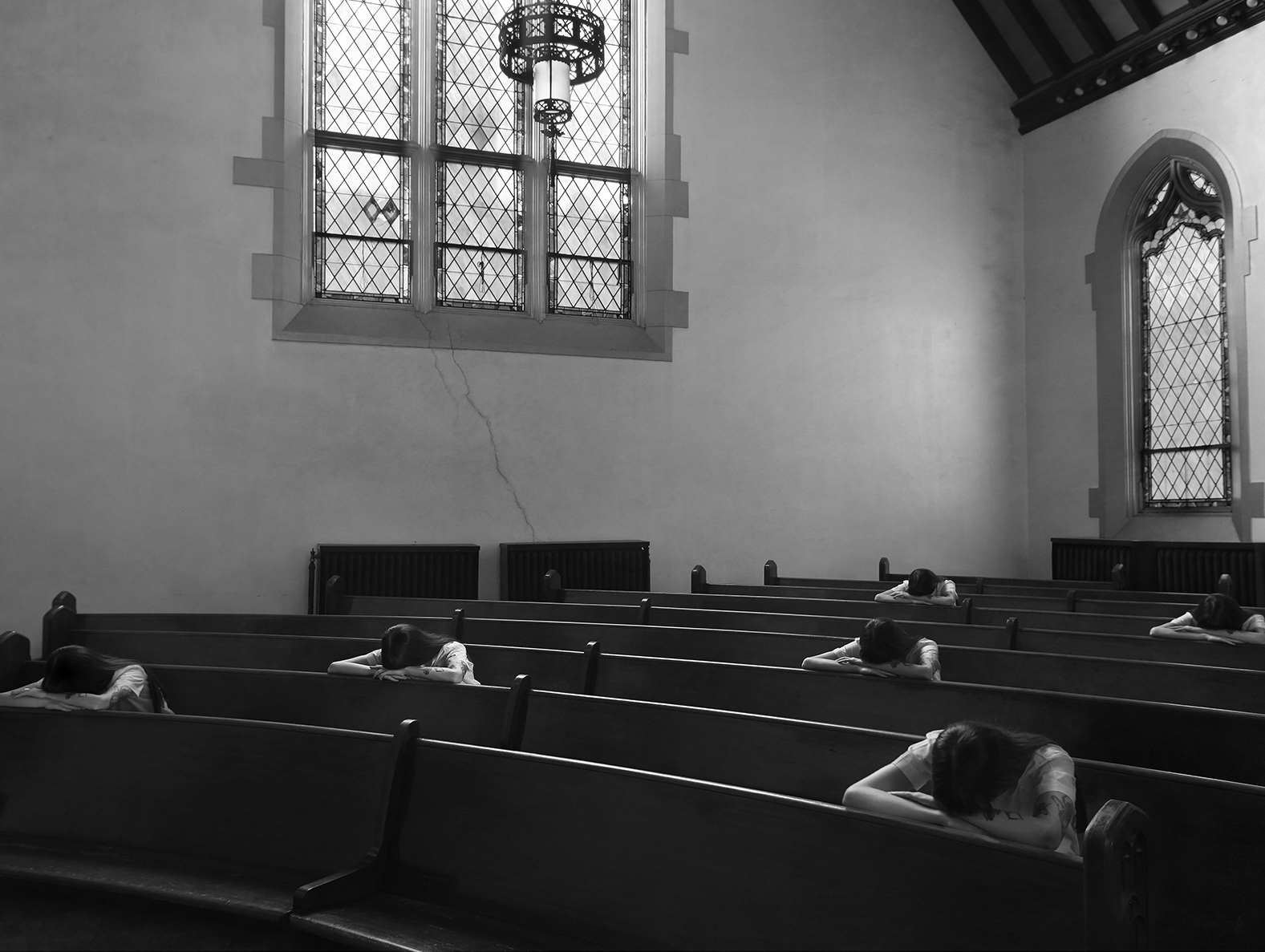Jackie Pallesen, Ehren Reed, & Sarah Davis. Photo by Crystal Rae Ludwick for LVA.
Post-centennial, Louisville Visual Art focuses on the next 100 years.
By Carmen Marti
Entire contents copyright © 2016 Carmen Marti. All rights reserved.
Notice the walls if you find yourself in a Metro-area Kroger store. Chances are there’s a mural painted by a Louisville artist, depicting the local community, paid for by the grocery. Through a partnership with Louisville Visual Art (LVA), more than 20 stores in towns ranging from New Albany to Stonybrook, Buckner to Buechel will have new, original art on their walls by 2019.
Reminiscent of public projects supported through the Works Progress Administration in the 1930s and ’40s, the program was developed as part of an effort by LVA to expand resources for professional artists in Louisville. Like the WPA, the Kroger program provides funding for public artworks. It reflects a belief that employment opportunities for artists serve not only to beautify and unite a community, they help drive the local economy through expanding the work force at large.
But the benefit “is not just in the employment of artists,” points out Ehren Reed, Outreach Program Coordinator at LVA. “Art helps with tourism, it helps create a more vibrant culture within a city. Art makes people want to stay in a place, makes people want to move there.”
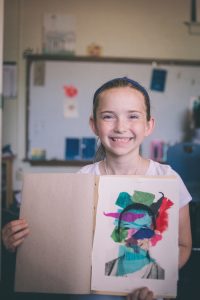
Intro to Photography student (7-10 yrs) Ardyn Hancock.Photo by Sarah Katherine Davis for LVA
Louisville has had longtime supporters of the arts, including the Louisville Fund for the Arts and LVA, which at 107 years old is the city’s oldest arts organization. But in the past few decades, Louisville has seen a resurgence in the arts scene, including the revitalization of Market Street, the rise of NuLu, and the redesign of the Speed Museum.
Louisville Visual Art has been part of that momentum. When its lease was not renewed at the Louisville Water Tower on Zorn Avenue in 2012, LVA used the transition to develop a strategic plan, create a new public identity, increase programming, and, in 2015 the organization bought a 32,000 square foot, two-story building on Lytle Street in the Portland warehouse district on the west side. Plans are to launch a capital campaign to renovate the space into a new, multi-use home within the next five years.
To lead LVA into this new phase, veteran arts administrator Lindy Casebier was appointed Executive Director in January 2016. And, according to Jackie Pallesen, Director of Education and Outreach at LVA, the board has been invigorated. “Because of the renaissance in our programming and our ability to show the community what we do really well,” she said, “our board members have become engaged in a different way.”
Now LVA is poised to become a hub for all ages in the art community—online, through programming, and in bricks and mortar. “Going through the strategic plan process was essential to getting us to this point,” said Pallesen. “When we moved out of the Water Tower, we really didn’t have a sense of place, and I think the community didn’t have a sense of place for us either.”
So LVA began asking questions—of itself, its board members, its benefactors, its beneficiaries: What is LVA’s mission; what are its strengths; what are its weaknesses?
“We really broke it down to three core things,” Pallesen said. “Visual Art Education, Community Outreach, and Artist Support.”
Visual Art Education is the umbrella for fine art classes. It is composed of the 91-year-old Children’s Fine Art Classes (CFAC), the Academy (the high school version of CFAC), and summer camps ranging from painting to multi-media arts to stop-motion animation.
Community Outreach encompasses the 27-year-old Open Doors programs for underserved populations in partnership with the Fund for the Arts; in-school residencies in mask-making, murals or a number of other selections as well as tailored programming; and community-based Louisville Metro partnership programs, such as Studio 2000 for high school students.
Artist Services traditionally has been largely an exhibitions program and the Artebella online gallery that was launched in 2012 and is now undergoing a refresh. “We found when we went through the strategic plan process that artist services is definitely one of our three key components,” said Reed, “but that we could really grow that aspect of our program.
Actually organizing everything into these three distinct components took the contribution of the entire LVA Board, topped off with a branding exercise led by board member Alexia Serpentini once the strategic plan was written. She helped the team design a new logo and establish buckets of activities, rather than individual flagship programs. “So, at the end of the day, we don’t have CFAC [Children’s Fine Art Classes], we have Visual Art Education,” Pallesen said. “We don’t have Open Doors, we have Community Outreach. We don’t have exhibitions, we have Artist Support.” It’s not Louisville Visual Art Association, it’s Louisville Visual Art.
This three-legged infrastructure has enabled LVA to establish a consistent public identity based on arts programming designed around the life cycle of an artist. “Doing the brand as part of the strategic plan solidified exactly who we are,” Pallesen said. “It is very clear to the public now.”
Sarah Davis is one reason LVA’s new identity is clear to the public. Last winter, in addition to coordinating the education programs, she was named Director of Marketing and Communications. A photographer and recent University of Louisville graduate, Davis has capitalized on knowing both contemporary media and LVA, where she has worked in one capacity or another since 2013.
“Engaging, inspiring, and improving our city and community,” said Davis, repeating LVA’s new mantra. “That’s what we’re trying to do.” She pushes that message through a roster of social media platforms, including Snapchat, Instagram, Twitter, and Facebook.
“One of my favorite moments,” recalled Davis, “was when I walked into a middle-school class taking photos and a student told me, ‘You do all the Instagram? It’s so good!’ We know the students are following our posts. They’re starting to understand that our classes are Louisville Visual Art, not ‘fun-art-time.’ We’re finally starting to get some brand recognition.”
Davis said cultivating this new generation, while nurturing longtime supporters is LVA’s goal. “We’ve always catered to the 50-plus crowd and we’re not going to stop,” she said. “But reaching the younger crowd is critical.”
This includes high schoolers and college students who are considering art careers. “One of our main goals is to create opportunities and access for kids so that they don’t feel like they have to leave Louisville,” Pallesen said. “And if they do leave Louisville for educational reasons then we want them to come back because exciting things are happening here.”
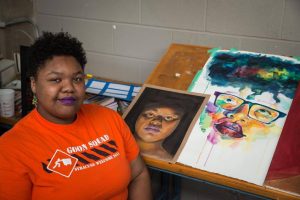
Artist and former CFAC student LaNia Roberts.
LaNia Roberts is one LVA alum who left Louisville for educational reasons, and she said she knows she’ll move back at some point. For now, Roberts is a junior at Syracuse University, majoring in studio arts with a focus in painting.
Roberts credits LVA with making a huge difference in her life. “I would not be where I am now if it weren’t for LVA,” she said. “I don’t come from an art family. My mother is a custodian and my father is a barber. LVA knew I didn’t have it financially, so they gave me financial aid each time I took classes.”
Roberts learned about LVA from her high school teacher, Patrick Robertson, Art and Humanities Chair at Central. As a young girl, Roberts had an on-again-off-again relationship with art. But when she heard about Instagram at the end of her sophomore year at Central High School, “I gave myself a challenge to complete two drawings everyday,” she said. “I did it for six weeks, and gained a following. By end of my junior year, I had 37,000 followers on Instagram. That was a really great part my early art career.”
Robertson suggested Roberts look into Louisville Visual Art for classes that would help her take the next step. His suggestion changed Roberts’ life. “LVA came at a crucial time,” she said. “Everything big in my portfolio, I did with LVA.”
And, because of LVA, Roberts was able to attend Governor’s School for the Arts, which helped her get in Syracuse, which helped inspire her to get a studio at the Mellwood Art Center before freshman year, and, “I had an art show and made enough money to get everything I needed for art school,” Roberts said. “That was a very important part of my life in terms of learning I can do anything.”
Other students learn valuable lessons through Studio 2000, a program under the Community Outreach rubric. Originally launched in 2000 by Metro Parks and Recreation, Studio 2000 was designed for young artists ages 14 to 18 on a visual art career path. Students not only apprentice with professionals, they create functional art of their own and at the end of eight weeks, after spending at least 12-hours-a-week in the studio, they not only earn a stipend, they show and sell their work at an exhibition that in 2015 was held at the Kentucky Center for the Arts.
At its peak, Studio 2000 supported 60 participants, each earning minimum wage. But in 2008, the program went dormant and wasn’t reinstated until 2013, when Metro Parks contacted LVA about starting again. Now the “learn and earn” program is a partnership with Metro Parks, which funds it, and LVA, which administers it.
Like the Visual Art programs, “One of the things that we’re really trying to emphasize with Studio 2000 is teaching the kids how to talk about their artwork,” said Reed, who manages Studio 2000 and serves as one of the teaching artists. To gain a spot in the competitive program (18 students were selected in 2015; 18 in 2016), applicants must submit letters of recommendation and a portfolio, including an artist’s statement.
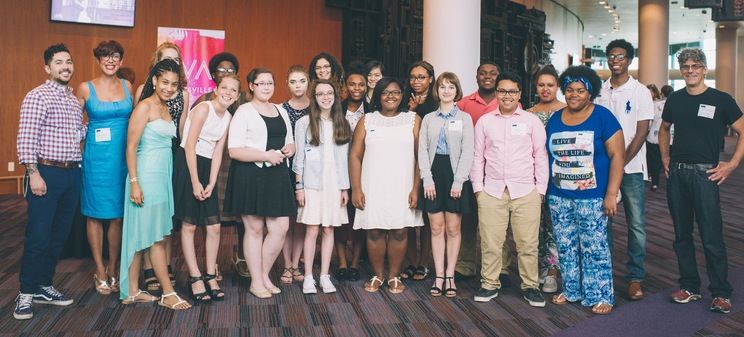
From left: Instructor Simon Gallo, Ehren Reed, the 2016 Studio 2000 students, and Instructor J.D. Schall. Photo by Sarah Katherine Davis for LVA.
Once admitted into the pre-professional program, all work is documented with studio photos for use in a portfolio, and a resume-ready experience.
Reed said the program helps students learn to appreciate well-crafted, finely finished work, and exposes them to galleries and hanging art. Through a speakers series, students meet artists who have found ways to apply artistic talent within the broader job market.
“Especially with Studio 2000, we want to show kids there are a lot of different ways that you can live creatively,” Reed said. She cites guest speakers ranging from tattoo artists to milliners, to custom auto painters. “A lot of the focus of the work leans towards design,” she said, “so it’s creating functional work as opposed to painting a picture.”
Julie Zamiska, an alum of Studio 2000, said the experience, “not only helped me grow as an artist but as a person. I learned skills I can use as a working artist and also that I can make a living being an artist.”
Another program that matches working artists with high school students is the Future is Now, a collaboration of LVA and the Kentucky College of Art + Design at Spalding University. A two-year-old initiative that has less of a work-study, technical focus than Studio 2000, the Future if Now is an opportunity for students to be mentored in developing conceptual work, pricing, and showing it. At the end of the three-month summer program, the students mount a three-week group exhibition at Spalding’s Huff Gallery.
These programs not only benefit the students who compete for the opportunity, but also the working artists who gain assistance and the reward of working with the next generation.
It is one of several new services LVA has initiated that expands opportunities for working artists in Louisville. The Kroger mural program was the first, and it has been so successful, LVA has begun developing another public mural program in conjunction with the Center for Neighborhoods, a nearly 50-year-old leadership and community planning organization, and Louisville Metro Government’s economic and community development initiative.
Another new initiative is the establishment of a professional development institute. It will provide classes for artists in a range of areas: websites, marketing, taxes, copyright. “We’re trying to create classes for everything artists need to know when trying to make a living,” said Pallesen, who oversees the classes and other new programming at LVA.
The institute will be housed in the new Portland building, along with other amenities such as a gallery, studios, and if dreams come true, a permanent auditorium. Having all those assets in one 32,000-square-foot location will be a luxury the likes of which LVA has never known.
“It’s just really exciting,” said Davis. “If we can build an auditorium and host events, and we do the classes and everything else all in one place—LVA will be the hub for our community.”
That’s the goal for the future anyway, the “fourth pillar,” as Davis calls it. “It’s the invisible one we don’t really talk about,” she said. “It’s future-facing. We’re ready to face the future.”
In Pallesen’s opinion that means facing the community. “This moment is not about telling the community what it needs,” she said. “It’s about asking the community what it needs and then listening.”
She thinks LVA is unique in taking that approach, and successful as a result of it. “The community has been vocal and we have been able to actually hear through the static and the noise,” Pallesen said.
They have heard a desire to continue long-time programs such as the summer camps, and the in-school offerings like 5×5, which facilitates five arts experiences by 5th grade for Jefferson County Public School students, and TAG, the Teacher Artist Grant program, both programs through the Fund for the Arts that serve middle and high school students and are available to teachers outside JCPS.
But LVA has also heard a need from new organizations that want to form new partnerships. For example, when the Fund for the Arts received a grant from Kosair Charities, the Fund partnered with LVA to implement two 28-week residencies this summer, one at the Visually Impaired Preschool Services, and a second at Home of the Innocents.

Mural in the Prospect Kroger by Ashley Brossart. Photo by Sarah Katherine Davis for LVA.
Other partnerships include the Louisville Ballet, the Louisville Story Program, which helps give voice to underrepresented residents of Louisville, and the Backside Learning Center, which supports equine workers and their families. “Jackie [Pallesen] is constantly making connections and meeting with people,” said Reed, Community Outreach coordinator. “Or people reach out to us and say, ‘Hey, we got this grant, we want to partner with an art’s organization and let’s figure out what that’s going to look like.’ Jackie brings all those things together.”
The latest initiative Pallesen and the LVA team have developed is the Mural Art Program, inspired by the Krogers murals. Officially launched on July 28, 2016, MAP unites local businesses, professional artists, Louisville Metro, and the greater Louisville community in the creation of large-scale murals.
“The Mural Art Program expresses Louisville’s unique identity and builds opportunities for artists, nonprofits, businesses and all citizens,” said Louisville Mayor Greg Fischer when the program launched. “Through MAP, we create a platform for community dialogue, and we make a commitment to working with emerging and established artists.”
Designed as a long-term public art program, MAP reflects a desire to empower diverse community voices. Because, said Reed, “Our goal is to get in there and help make things happen. We’re a unique organization, uniquely positioned to do this specific kind of work. We don’t want something that’s a flash in the pan; we want to create a sustainable culture for visual art in this community.”
“This is the next 100 years,” added Pallesen. “We hit our 100-year mark, and now we’re beginning to shape the next 100 years.”
Carmen Martí As a professional writer and editor for more than 20 years, and an independent contractor since 1995, Carmen Martí has filled a variety of writing and editing roles in print media, health care, education, business and the arts. She worked fulltime as a publicist for the University of Chicago News Office from 1991-1995, as an editorial assistant for Inside Chicago magazine from 1989-1991, and as a high school English and humanities teacher at the Harvard School from 1986-1990.


